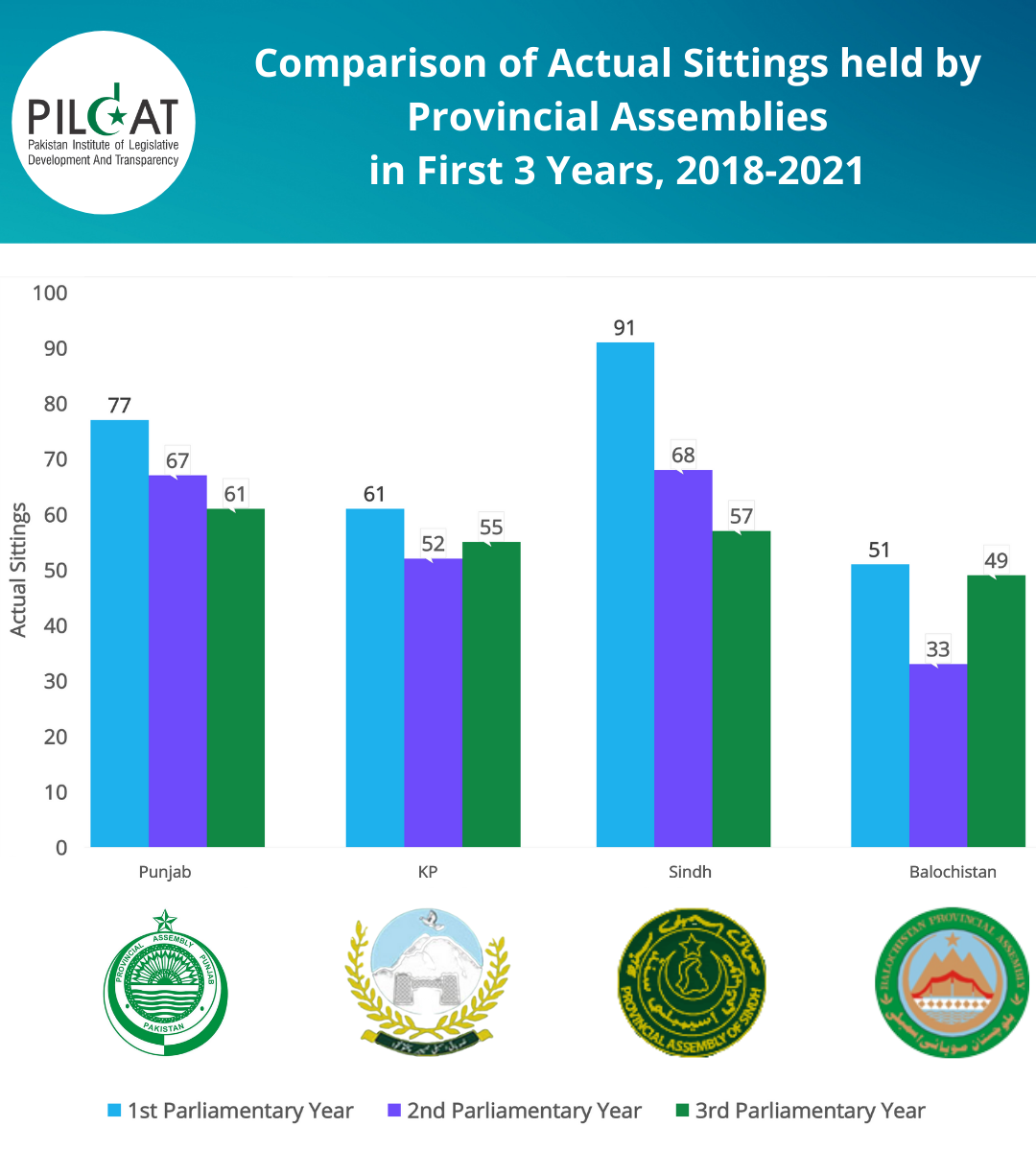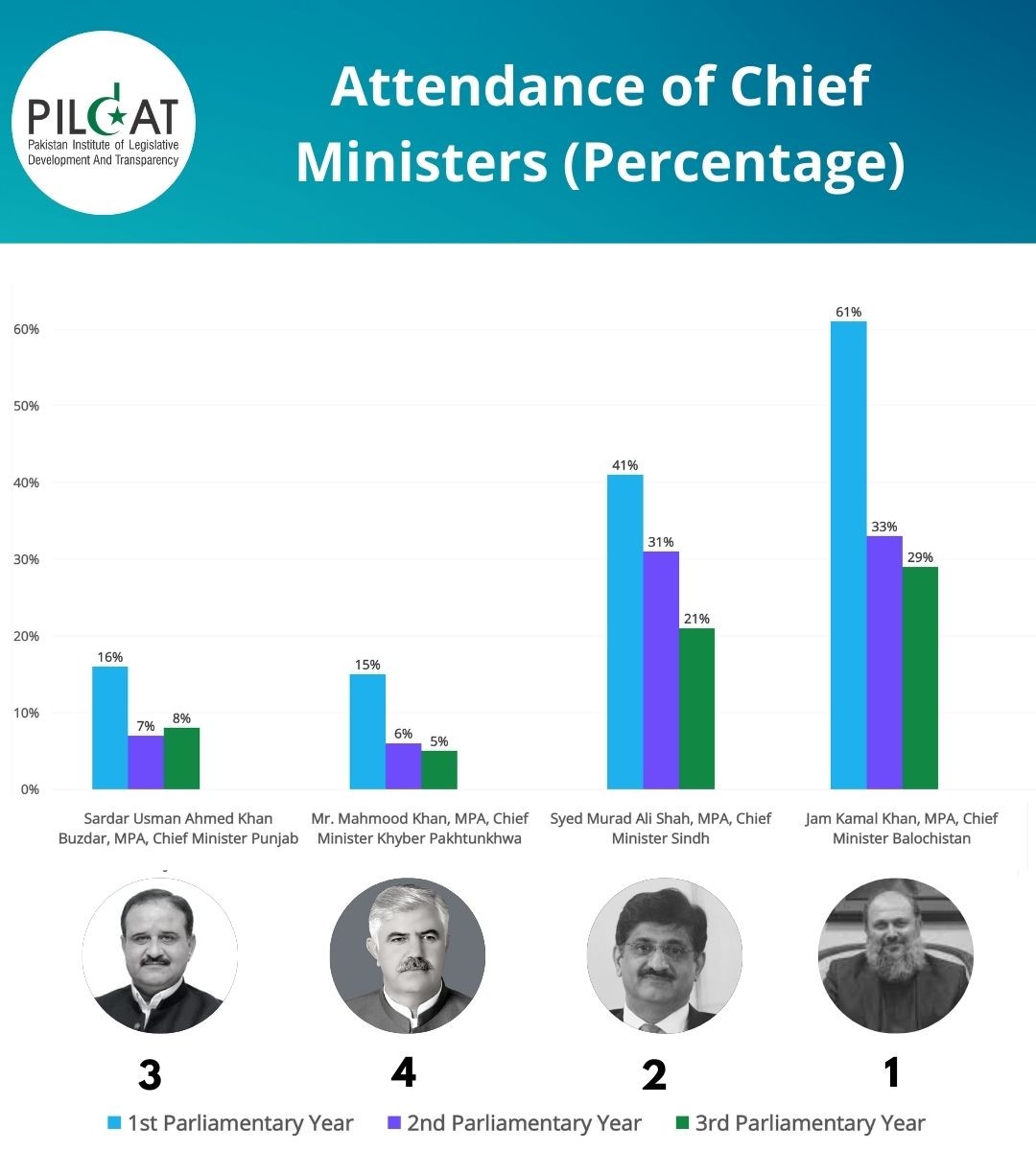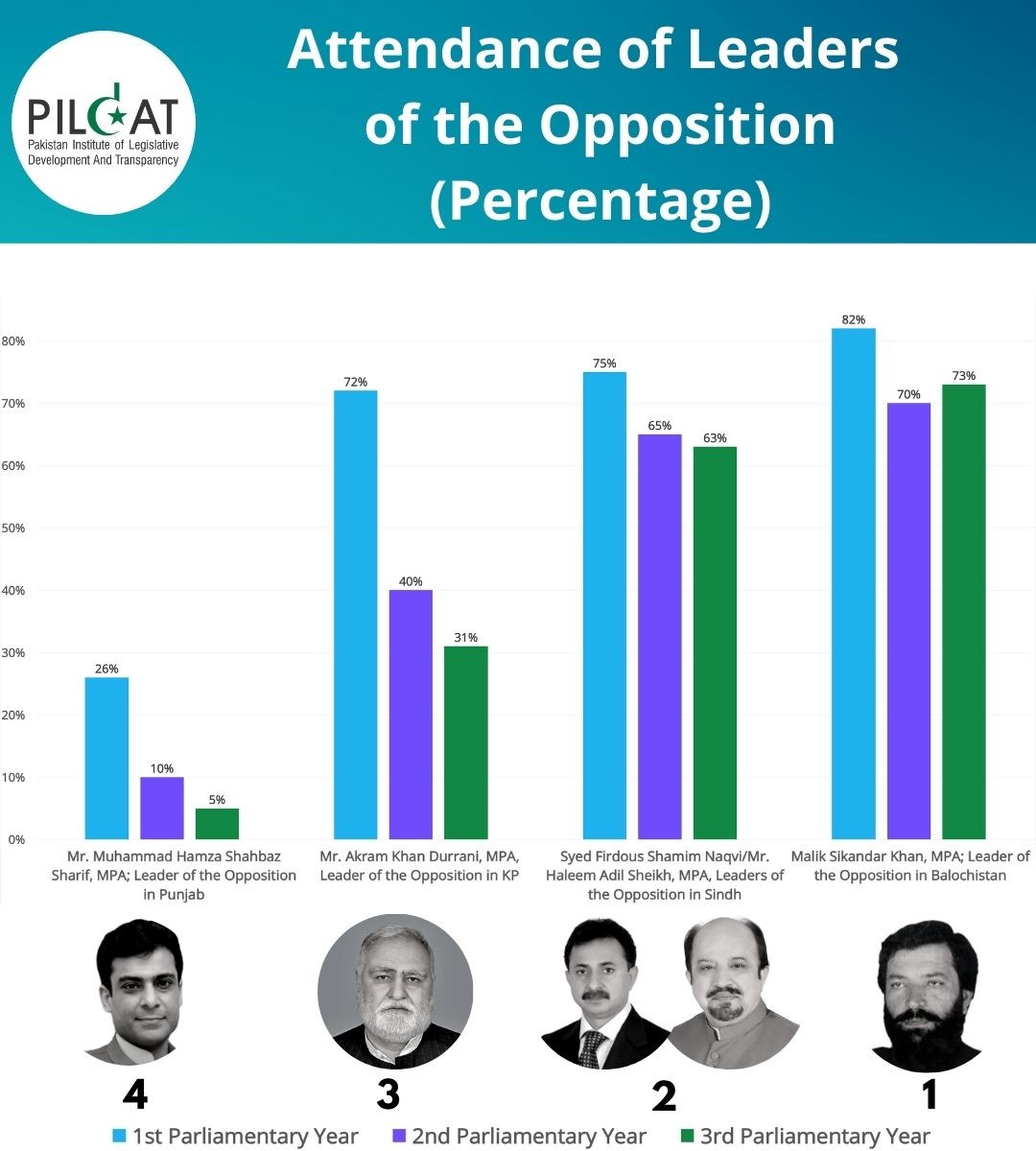-
Three out of four Provincial Assemblies record decrease in average working hours per sitting compared to second and first parliamentary years
-
Sindh Assembly passes most Laws; KP Assembly leads with highest Working Hours
-
Punjab Assembly holds most Sittings but lowest working hours
-
Balochistan Assembly registers a record increase of 48% in the sittings in third year compared to the second year
-
Provincial Assembly of Balochistan ranks last in legislative activity, working days and budget session but first in CM’s attendance during third parliamentary year
-
CM Balochistan attends 29% sittings; CM Sindh attends 21% sittings; CM Punjab attends 8% sittings and CM KP attends 5% sittings of respective Provincial Assemblies in 3rd Parliamentary Year
August 31; As Provincial Assemblies have completed third parliamentary year, a PILDAT comparative assessment of performance of Pakistan’s 4 Provincial Assemblies shows that while Assemblies outrank each other in different KPIs, each Assembly records a decline in legislation, working hours and attendance of Chief Ministers compared to second parliamentary year.
Working Days (Sittings)
Provincial Assembly of the Punjab has met for the highest number of sittings, 61, during the third parliamentary year in a comparative analysis of sittings held by each of the four Provincial Assemblies. Provincial Assembly of Sindh has met for 57 sittings during the year, followed by Provincial Assembly of Khyber Pakhtunkhwa that has held 55 sittings in year 3 and Provincial Assembly of Balochistan which only met for 49 sittings.
 However, the sittings of the Punjab Assembly have reduced by about 9% from 67 in year 2 to 61 in year 3. Sittings of Provincial Assembly of Sindh during the third year have declined by 16% from the 68 sittings held in the second parliamentary year. Sittings of the Provincial Assembly of Khyber Pakhtunkhwa in year 3 have recorded an increase of nearly 6% from second parliamentary year when the Assembly had held 52 sittings. Sittings of the Provincial Assembly of Balochistan during third parliamentary year have seen an increase of 48% over 33 sittings held during the second year.
However, the sittings of the Punjab Assembly have reduced by about 9% from 67 in year 2 to 61 in year 3. Sittings of Provincial Assembly of Sindh during the third year have declined by 16% from the 68 sittings held in the second parliamentary year. Sittings of the Provincial Assembly of Khyber Pakhtunkhwa in year 3 have recorded an increase of nearly 6% from second parliamentary year when the Assembly had held 52 sittings. Sittings of the Provincial Assembly of Balochistan during third parliamentary year have seen an increase of 48% over 33 sittings held during the second year.
 A comparison of average sittings per year held by the Provincial Assembly of the Punjab in the first three years during the current 2018-2023 term at 68 sittings with that of the average sittings held in three years of the previous Provincial Assembly of the Punjab (2013-2018) at 69 shows a slight reduction in sittings by 1.45%.
A comparison of average sittings per year held by the Provincial Assembly of the Punjab in the first three years during the current 2018-2023 term at 68 sittings with that of the average sittings held in three years of the previous Provincial Assembly of the Punjab (2013-2018) at 69 shows a slight reduction in sittings by 1.45%.
When compared to the average 72 sittings held in the first three years during the current 2018-2023 term of the Provincial Assembly of Sindh, with that of the average sittings held in three years of the previous Provincial Assembly of Sindh at 60, the Sindh Assembly has held 20% more sittings.
The Provincial Assembly of Khyber Pakhtunkhwa has met for fewer sittings on average, 56 in the first three years, or 7% fewer sittings during the current term when compared to the average sittings of 60 in the first three years of the previous Provincial Assembly of KP.
The Provincial Assembly of Balochistan has met for an average of 44 sittings in the first three years, or 10% fewer sittings during the current 2018-2023 term when compared to the average sittings of 49 in the first three years of the previous Provincial Assembly of Balochistan.
Working Hours
 The Provincial Assembly for Khyber Pakhtunkhwa ranks on the top when compared with other Provincial Assemblies in terms of 147.02 working hours during the third year. The working hours of the Assembly have recorded an increase of about 30% when compared to 113.32 working hours during the second year of the Assembly.
The Provincial Assembly for Khyber Pakhtunkhwa ranks on the top when compared with other Provincial Assemblies in terms of 147.02 working hours during the third year. The working hours of the Assembly have recorded an increase of about 30% when compared to 113.32 working hours during the second year of the Assembly.
The Provincial Assembly of Sindh has met for 126.14 working hours which is a decrease of about 25% in working hours compared to the second year when the Assembly met for 168.15 working hours.
The working hours of 124 during the third parliamentary year in the Provincial Assembly of Balochistan have increased by about 11% from the second parliamentary year when the Assembly had met for 111.39 working hours.
In its third parliamentary year, the current Punjab Assembly has been convened for 102.44 hours compared to 140.32 hours during the second parliamentary year, recording a decrease of 27% in working hours between two years.
 The average working hours in the first 3 year of current term of the Sindh Assembly at 198.51 have increased by about 8% from the average working hours of 184 recorded in the first three years of the previous Provincial Assembly of Sindh.
The average working hours in the first 3 year of current term of the Sindh Assembly at 198.51 have increased by about 8% from the average working hours of 184 recorded in the first three years of the previous Provincial Assembly of Sindh.
The Provincial Assembly of the Punjab in the first three years during the current term met for an average of 138.36 hours. However, the previous Provincial Assembly of the Punjab had met for an average 189 working hours in first three years, which is a decrease of about 27% in working hours of the Punjab Assembly.
The average working hours in first three years of the Provincial Assembly of Khyber Pakhtunkhwa at 137.27 have recorded an increase of about 5% when compared to 131 average working hours recorded in first three years of the previous Provincial Assembly of Khyber Pakhtunkhwa.
When compared with average working hours in the first three years of the current Provincial Assembly of Balochistan at 134.42, the Balochistan Assembly has met for about 21% more working hours than the previous Balochistan Assembly which had been convened for an average of 111 working hours in its first three years.

During the third year, average working hours per sitting work out to be 1.42 in Punjab Assembly, 2.13 in Sindh Assembly, 2.4 in KP Assembly and 2.32 in Balochistan Assembly.

During the third parliamentary year, the allocated budget per working hour is calculated to be PKR 25.7 M per working hour in the Provincial Assembly of the Punjab, PKR 21.6 M per working hour in the Provincial Assembly of Sindh, PKR 17.2 M per working hour in Provincial Assembly of Balochistan and PKR 8.8 M per working hour in the Provincial Assembly of Khyber Pakhtunkhwa. In this sense, the KP Assembly is the most cost-effective provincial assembly followed by Balochistan Assembly and Sindh Assembly with Punjab Assembly being the least cost effective.
Attendance of Chief Ministers

During the third year, Chief Minister Balochistan, Jam Kamal Khan, MPA, has attended the highest percentage (29%) of sittings of the Provincial Assembly of Balochistan followed by Syed Murad Ali Shah, MPA and Chief Minister Sindh who has attended 21% sittings of the Sindh Assembly. A distant third is Sardar Usman Ahmed Khan Buzdar, MPA and Chief Minister of Punjab who only joined 8% sittings of the Punjab Assembly. In the last position is Mr. Mahmood Khan, MPA and Chief Minister Khyber Pakhtunkhwa who has attended only 5% sittings of the Provincial Assembly of Khyber Pakhtunkhwa.
In general, with each passing parliamentary year, each Provincial Assembly has witnessed a decrease in attendance of Chief Ministers in Assembly sessions with the only exception of CM Punjab whose attendance during the third year improved by a miniscule 1 percentage point over the second year.
29% attendance of Chief Minister Balochistan during the third year had decreased by 4 percentage points compared to 33% attendance during the second year.
Attendance of Syed Murad Ali Shah, MPA and Chief Minister Sindh has declined by 10 percentage points from year 2 when he attended 31% sittings and year 3 when he could attend only 21% sittings.
8% attendance of Sardar Usman Ahmed Khan Buzdar, MPA, Chief Minister Punjab increased by one percentage point in the third year compared to 7% in the second year.
In the third parliamentary year, 5% attendance of Mr. Mahmood Khan, MPA, Chief Minister Khyber Pakhtunkhwa, declined by one percentage point from 6% attendance during the second year.
Attendance of Leaders of the Opposition

Leader of the Opposition in the Provincial Assembly of Balochistan, Malik Sikandar Khan, MPA, tops in the comparative analysis as he attended 73% sittings of the Balochistan Assembly during the third parliamentary year. Attendance of the Leader of the Opposition in Sindh Assembly was 63%. ( It must be noted that Syed Firdous Shamim Naqvi, MPA resigned as the Leader of the Opposition on January 08, 2021 and Mr. Haleem Adil Sheikh, MPA replaced him on January 26, 2021. This is a combined attendance of both .) Mr. Akram Khan Durrani, MPA and Leader of the Opposition in the Provincial Assembly of Khyber Pakhtunkhwa attended 31% sittings of the assembly. Mr. Muhammad Hamza Shahbaz Sharif, MPA and Leader of the Opposition in the Punjab Assembly only attended 5% sittings of the Assembly in the third parliamentary year. It must be noted that Mr. Muhammad Hamza Shahbaz Sharif was arrested by the National Accountability Bureau (NAB) in June 2019 and was released on bail 20 months later in February 2021.
Legislation

During the third parliamentary year ending on August 12, 2021, Provincial Assembly of Sindh has passed 38 bills, followed by Provincial Assembly of the Punjab which has passed 34 bills, Provincial Assembly of Khyber Pakhtunkhwa which has passed 33 bills and Provincial Assembly of Balochistan which has passed 26 bills.
 In terms of average bills passed by each Provincial Assembly in three years of the current term (2018-21) compared to the 3 years average of previous terms (2013-16) of each Provincial Assembly, only the Provincial Assembly of Khyber Pakhtunkhwa has recorded improved legislative activity of average 122 bills compared to 83 bills in previous tenure. This is an increase of 47% in average legislative activity. The Provincial Assembly of Sindh has passed an average of 74 bills or 35% fewer bills in first three years compared to the average of 114 bills passed by previous assembly in first three years. The Provincial Assembly of Balochistan has passed 45 bills on average in first three years, which is a decrease of 25% bills compared to average 60 bills passed in first three years of the previous Balochistan assembly. The Provincial Assembly of Punjab has passed an average of 92 bills in first three years which is a decrease of 19% compared to the average of 114 bills passed by previous Punjab Assembly in first three years.
In terms of average bills passed by each Provincial Assembly in three years of the current term (2018-21) compared to the 3 years average of previous terms (2013-16) of each Provincial Assembly, only the Provincial Assembly of Khyber Pakhtunkhwa has recorded improved legislative activity of average 122 bills compared to 83 bills in previous tenure. This is an increase of 47% in average legislative activity. The Provincial Assembly of Sindh has passed an average of 74 bills or 35% fewer bills in first three years compared to the average of 114 bills passed by previous assembly in first three years. The Provincial Assembly of Balochistan has passed 45 bills on average in first three years, which is a decrease of 25% bills compared to average 60 bills passed in first three years of the previous Balochistan assembly. The Provincial Assembly of Punjab has passed an average of 92 bills in first three years which is a decrease of 19% compared to the average of 114 bills passed by previous Punjab Assembly in first three years.

Comparative analysis on legislation contrasts sharply with budget allocation to each Assembly per member during the year. Balochistan, which has passed the lowest number of laws has the highest budget allocation per member at about PKR 32.9 M per member during the third parliamentary year. Per member budget of the Provincial Assembly of Sindh in third parliamentary year is PKR 16.2 M. Budget allocation per member in the third year of Provincial Assembly of Khyber Pakhtunkhwa is PKR 8.9 M. The budget allocation per member in Punjab Assembly of Punjab is PKR 7.1 M which is the least compared to the other three provinces.

Scrutiny and passage of the annual finance bill or budget of each province is the key responsibility of each Assembly every year. Despite this, and while crucial reforms in strengthening budget process across each Assembly has been pending year after year, limited working days and time is spent by each Assembly in its budget session. In the third parliamentary year, Provincial Assembly of the Punjab has spent 12 days in budget session, down from 13 days spent in year 2. Budget session during third parliamentary year in the Provincial Assembly of Khyber Pakhtunkhwa was only 9 days, compared to 7 days in year 2. Provincial Assembly of Sindh has spent 8 days in its budget session during parliamentary year three, compared to 10 days of budget session in parliamentary year 2. Provincial Assembly of Balochistan has utilized only 7 days in its budget session during the third parliamentary year, consistent with the number of days in year 2.
Instead of accelerating their performance on each of the key performance indicators (KPIs), Provincial Assemblies have shown a declining trend across most, if not all, KPIs. Much like the previous years, little or no initiative has been taken in inviting public input and involvement and enhancing transparency and access for citizens.






